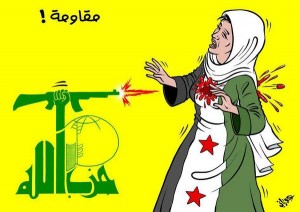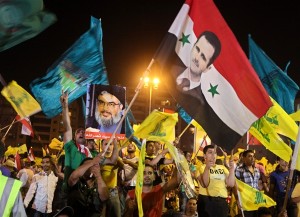 Beirut, Lebanon- A Syrian government militia that the U.S. has declared a terrorist organization is becoming increasingly important to the Syrian government’s strategy as it attempts to shore up its still-loyal but beleaguered military.
Beirut, Lebanon- A Syrian government militia that the U.S. has declared a terrorist organization is becoming increasingly important to the Syrian government’s strategy as it attempts to shore up its still-loyal but beleaguered military.
The militia, known as the National Defense Force or the People’s Army, is an extension of the shabiha, the pro-government gangs that were used to suppress demonstrations against the government of President Bashar Assad and that have been accused over the last two years of massacring civilians in rebel-held areas.
Made up of Syria’s two largest religious minorities, Shiite Muslims and Alawites, the militia has been training in the cities of Latakia and Tartus, and it’s been increasingly active in the provinces of Homs and Hama.
Latakia and Tartus, both on the Mediterranean Sea and in Syria’s Alawite heartland, are the country’s last two urban areas that have seen no fighting.
Syria’s population is largely Sunni Muslim, as are the rebels battling the government. Bashar Assad, whose family has ruled Syria for more than four decades, is an Alawite, a sect that’s related to Shiite Islam. Though support for Assad among Syria’s Alawites isn’t monolithic, it’s widespread.
Many say the growth of the militia is just one more step in the militarization of Syrian society. The anti-Assad rebel forces already are made up primarily of civilians who’ve left their regular lives to fight.
“They have been in control of the battles in Homs since October,” said Amal, who was reached by phone in Khaldiya, a neighborhood in central Homs that’s seen heavy fighting in the last year.
 The neighborhood remains split between rebels and government supporters, but the army has largely withdrawn to deploy in other areas where rebels are fighting the government. Residents have said that Homs in general is quieter now as the military has surrounded the rebels in the city, largely cutting them off from their supplies and reinforcements.
The neighborhood remains split between rebels and government supporters, but the army has largely withdrawn to deploy in other areas where rebels are fighting the government. Residents have said that Homs in general is quieter now as the military has surrounded the rebels in the city, largely cutting them off from their supplies and reinforcements.
“There aren’t a lot of soldiers in my neighborhood,” said Amal, who asked to be identified only by her first name because she feared for her security.
She described militia members as reporting to local leaders who coordinate with the army and the security forces. Much of the militia’s equipment is from the army, and it includes heavy weaponry such as tanks and artillery.
“My cousin is 17. He drives a tank and can fire it,” Amal said.
She said there was little debate about the authority of the militia in her neighborhood. “Society is in a state of war, and this is why these militias are in control,” she said.
The U.S. government has identified Hezbollah, the Lebanese militia that’s allied with Iran and Syria, as being involved in training the Syrian militia, along with members of Iran’s Islamic Revolutionary Guard Corps. Syrians familiar with the militia also say that some of its leaders have been sent to Iran for training, much the way Hezbollah fighters and Iraqi Shiite militias trained there in past years.
The United States declared the group, known in Arabic as Jaish Shabi, a terrorist organization in December at the same time that it named a rebel faction, the Nusra Front, as an alias for al Qaida in Iraq.
Will Fulton, an Iran expert with the conservative American Enterprise Institute in Washington, said it appeared that part of the Islamic Revolutionary Guard Corps’ mission was building a force that might survive if Assad’s government lost control of the country.
“Iran would like to see something in place after Assad falls,” Fulton said.
A Hezbollah fighter from Beirut who said he’d been to Syria a few times in the past year said Hezbollah was helping the Syrian militia with strategy but that the extent of Hezbollah’s involvement in the conflict had been exaggerated.
When he was asked how many fighters he knew who’d died in Syria in recent months, he declined to answer. Hezbollah had denied direct involved in the conflict until it became nearly impossible for it to hide the funerals taking place in its Lebanese strongholds for fighters killed in Syria.
Hezbollah’s direct involvement appeared to increase over the weekend, with clashes on the Syrian side of the border with Lebanon that reportedly left at least a dozen rebels and three Hezbollah fighters dead. According to rebel sources, Hezbollah was attempting to expand its control over villages along the border.
The interview with the fighter, who used the pseudonym Dany because the group’s media department hadn’t authorized him to discuss such matters, offered a chilling window into the intractability of the Syrian war. In addition to Hezbollah fighters who are deployed in Syria, particularly on the Lebanese-Syrian border, Shiites from Iraq have volunteered to fight on Assad’s behalf, Dany said.
Iran also could use the Jaish Shabi _ Arabic for “People’s Army” _ as a proxy to pursue its political objectives in Syria, much as it uses Hezbollah to promote its interests in Lebanon.
Dany’s reasons for fighting in Syria sounded quite similar to one of the U.S. government’s rationales for invading Iraq 10 years ago: the need to stop Sunni extremists.
“We must stop these takfiris before they reach Lebanon,” he said, using an Arabic word that denotes religious extremists who believe that Shiites are apostates. “We’re going to go to Syria to fight because we have to stop it there.”
For many, the formal training of the shabiha as a national militia just means more bloodshed.
“My hometown is 75 percent Alawite and 25 percent Christian,” said Nour, a 24-year-old woman from Maysaf, a small city near Homs. “The Alawites were armed a long time ago. So the new name is just a new name.”
She said the militia was particularly strong in Houla, a city where the shabiha were accused last year of hacking to death dozens of Sunni civilians, including women and children.
Nour complained that the rise of the militia had led to a breakdown in law and order in her area, as it supplanted the authority of more traditional police forces. She said that while there wasn’t much fighting in her town, the militia played a role in supporting combat elsewhere.
“Last summer a young teenager threatened the Christian guys with a pistol after they kicked them out of the neighborhood because he was hitting on the girls here,” she said. “And they said to him specifically: If you’re a real man, go fight in Houla, not here!”
“They do whatever they want and nobody stops them,” she said, admitting that the breakdown of order in the area had prompted her family recently to purchase a gun.
She expressed ambivalence about the growth of the militia. “I don’t really know how I feel about it,” she said. “We are being controlled by those thugs, and we can’t say anything against the regime.” At the same time, she acknowledged being fearful of a takeover by Sunni rebels.
“I used to go to another village to work every day, but one person was kidnapped, then killed on that road, so now I can’t go to work because it’s not safe,” she said.
In Latakia, one 25-year-old resident reached by phone said members of the militia often engaged in kidnapping and robberies to fund their activities.
“Any rich person is a possible prey,” said the resident, who asked to be identified only as Khalid for security reasons. “Even if you fund them, you might get kidnapped by them. They get security IDs or assignment papers so they don’t get stopped or searched at checkpoints.”
He said that one of the most active units of the militia, called Liwa al Jbal, or the Mountain Brigade, was led by Hilal Assad, one of the president’s cousins.
“If you want to volunteer, you go to Hilal Assad’s people,” he said. “They test your rifle, then you go to the mountain to fight with the army.”
One benefit of volunteering for the militia, he said, is remaining in your home area rather than being assigned to some far-off province to fight. The militia also provides IDs, which are honored at checkpoints, along with a sense of prestige.
“Many people volunteered because it’s a powerful position,” he said. “There are many teenagers in the militia. They are untouchable.”
Khalid said the impunity with which militia members operated had angered other residents, but “there’s nothing anyone can do about it.”
“Alawites are scared of being exterminated. They are let down by the president, and believe the future will be terrible,” he said, explaining why the militia is tolerated.
Jonathan S. Landay in Washington and a special correspondent in Beirut who isn’t being named for security reasons contributed to this article.
Miami Herald

Leave a Reply
You must be logged in to post a comment.